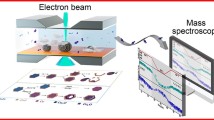Abstract
The ability of a high surface-area gibbsite to adsorb Cu2+ was studied using a Cu2+ ion-selective electrode, electron spin resonance, infrared spectroscopy, and electron microscopy. The gibbsite chemi-sorbed small amounts of monomelic Cu2+ (<0.5 mmole/100 g) which was oriented with its z-axis perpendicular to the (001) plane of the mineral. The proposed chemisorption sites are at gibbsite crystal “steps” observed by electron microscopy. Although Cu2+ adsorption on gibbsite as a function of pH was largely reversible, exposure of the chemisorbed Cu2+ to NH3 did not result in desorption from the surface despite the displacement of several OH− or H2O ligands by NH3. The results indicate that at least one Cu-O-Al bond is formed in the process of chemisorption.
At pH > 5, the gibbsite appeared to promote the hydrolysis and polymerization of Cu2+, with further adsorption at the surfaces. Infrared spectroscopy revealed no effect of the adsorption on the (001) surface hydroxyl groups, although the anisotropic diffusion of protons in the gibbsite structure was verified from deuteration studies.
Резюме
Способность гиббсита с большой площадью поверхности к адсорбции Cu2+ исследовалась при помощи Cu2+-ионоселективного электрода, электронного спинового резонанса, инфракрасной спектроскопии и электронного микроскопа. Гиббсит хемисорбировал малые количества моно-мерного иона Cu2+ (<0,5 ммоль/100 г), ось z которого была направлена вертикально к плоскости (001) минерала. Предложенные места хемисорбции находятся на кристаллических “ступенях” гиббсита, наблюдаемых при помощи электронного микроскопа. Хотя адсорбция Cu2+ на гиббсите как функция pH является в значительной степени обратимой, экспонирование хемисорбированного Cu2+ к NH3 не приводило к десорбции с поверхности несмотря ра замещение нескольких OH− или лигандов H2O группами NH3. Результаты указывают на то, что по крайней мере одна связь Cu-O-Al формируется во время процесса хемисорбции.
При pH >5, гиббсит способствует гидролизу и полимеризации Cu2+, c добавочной адсорбцией на поверхностях. Инфракрасная спектроскопия не обнаруживала никакого эффекта адсорбции на гидроксиловых группах плоскости (001), хотя анизотропная диффузия протонов в структуру гиббсита подтверждалась исследованиями при использовании дейтерия. [E.G.]
Resümee
Es wurde die Fähigkeit von Gibbsit mit großer Oberfläche Cu(II) zu adsorbieren untersucht, wobei eine Cu(II) Ionen-selektive Elektrode, Elektronenspinresonanz, Infrarotspektroskopie und Elektronenmikroskopie verwendent wurde. Der Gibbsit chemisorbierte kleine Mengen von monomerem Cu(II) (<0,5 × 10−3 Mol/100 g), wobei das Ion mit seiner z-Achse senkrecht zur (001) Ebene des Minerals orientiert wurde. Die vorgeschlagenen Chemisorptionsstellen sind beim Gibbsit Kristall-“Stufen,” die mittels Elektronenmikroskopie beobachtet wurden. Obwohl die Cu(II)-Adsorption an Gibbsit in Abhängigkeit vom pH-Wert weitgehend reversibel war, ergab die Behandlung des chemisorbierten Cu(II) mil NH3 keine Desorption von der Oberfläche, obwohl einige OH−- oder H2O-Liganden durch NH3 ersetzt wurden. Diese Ergebnisse deuten darauf hin, daß mindestens eine Cu-O-Al-Bindung im Verlauf der Chemisorption gebildet wird.
Bei pH-Werten über 5 schien der Gibbsit die Hydrolyse und Polymerisation von Cu(II) zu fördern, bei weiterer Adsorption an die Oberflächen. Infrarotspektroskopische Untersuchungen zeigten keine Auswirkung auf die Adsorption an die Hydroxylgruppen der (001) Oberfläche, obwohl die anisotrope Diffusion von Protonen in der Gibbsitstruktur durch Deuterierungsuntersuchungen bestätigt wurde. [U.W.]
Résumé
L’abilité d’une gibbsite ayant une large aire de surface pour adsorber Cu2+ a été étudiée en utilisant une électrode sélectionnant l’ion Cu2+, le spin à résonnance d’électrons, la spectroscopie infrarouge, et la microscopie électronique. La gibbsite a chémisorbé de petites quantités de Cu2+ monomérique (<0,5 mmole/100 g) qui était orienté avec son axe-z perpendiculaire au plan (001) du minéral. Les sites de chemisorption proposés sont à des “étapes” du cristal de gibbsite observées par microscopie électronique. Quoique l’adsorption de Cu2+ sur la gibbsite en fonction du pH était largement réversible, l’exposition de Cu2+ chémisorbé au NH3 n’a pas résulté en une désorption de la surface malgré le déplacement de plusieurs ligands OH− ou H2O par NH3. Les résultats indiquent qu’au moins un lien CU-O-Al est formé pendant le procédé de chémisorption.
A un pH >5, la gibbsite semblait promouvoir l’hydrolyse et la polymerisation de Cu2+, avec d’avantage d’adsorption aux surfaces. La spectroscopie infrarouge n’a révélé aucun effet de l’adsorption sur les groupes hydroxyles de surface (001), quoique la diffusion anisotropique de protons dans la structure de la gibbsite a été verifiée par des études de deuteration. [D.J.]
Similar content being viewed by others
References
Farrah, H. and Pickering, W. F. (1976) The sorption of copper species by clays: II. Illite and montmorillonite: Aust. J. Chem. 29, 1177–1184.
Gastuche, M. C. and Herbillon, A. (1962) Etude des gels d’alumine; cristallisation en milieu desionise: Bull. Soc. Chim. Fr. 5, 1404–1412.
Martini, G. and Burlamacchi, L. (1979) ESR study of copper-ammonia complexes in solution adsorbed on silica gels. 1. Wide-pore silica gels: J. Phys. Chem. 83, 2505–2511.
McBride, M. B. (1982a) Cu2+-adsorption characteristics of aluminum hydroxide and oxyhydroxides: Clays & Clay Minerals 30, 21–28.
McBride, M. B. (1982b) Hydrolysis and dehydration reactions of exchangeable Cu2+ on hectorite: Clays & Clay Minerals 30, 200–206.
Russell, J. D., Parfitt, R. L., Fraser, A. R., and Farmer, V. C. (1974) Surface structures of gibbsite, goethite, and phos-phated goethite: Nature 248, 220–221.
Author information
Authors and Affiliations
Rights and permissions
About this article
Cite this article
McBride, M.B., Fraser, A.R. & McHardy, W.J. Cu2+ Interaction with Microcrystalline Gibbsite. Evidence for Oriented Chemisorbed Copper Ions. Clays Clay Miner. 32, 12–18 (1984). https://doi.org/10.1346/CCMN.1984.0320102
Received:
Accepted:
Published:
Issue Date:
DOI: https://doi.org/10.1346/CCMN.1984.0320102




